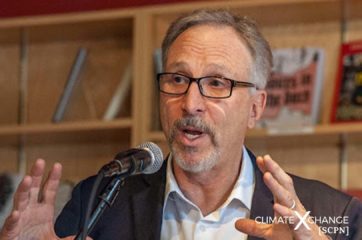All across the country, members of our State Climate Policy Network (SCPN) are fighting to make an impact on climate change in their communities. We have individuals in our Network from all 50 states, each experiencing climate change differently in their local areas and finding unique solutions to build resiliency efforts.
Melinda Hanson has spent her career working to decarbonize urban transport. She is currently the Co-Founder and Principal at Electric Avenue, a public affairs and mobility strategy firm. Prior to Electric Avenue, Melinda was Head of Sustainability at Bird, where she oversaw sustainability research and policy development and led efforts to maximize environmental benefits across the company’s operations.
Ava Gallo
Thank you so much for taking the time to speak to us today as part of our Spotlight series. I’d love to start off by you telling me a bit more about your background and the work you are doing right now.
Melinda Hanson
So my background is at the intersection of sustainable transportation and climate policy. I started my career working at the city of San Francisco to better understand the jobs/housing balance and how that impacted environmental factors as well as equity factors. And then went on to work on climate policy at a pretty high level at ClimateWorks Foundation, where we focused on international negotiations and national-level policy setting.
That’s where I got more interested in transportation. Sometimes the climate world can feel intangible; it’s hard to get your hands around it. But the transportation component was very interesting to me, because of the intersectionality of the issue. It is something that is crucial to people’s livelihoods, to how good their quality of life is, to various social factors, and of course the environment.
So I transitioned towards transportation policy, dabbled in some urban design, and did some real implementation work on bus projects and bicycle projects in Asia and Africa. A few years ago, I moved to the private sector where I specialize in light electric vehicles and market entry for new companies who are trying to entice people out of cars and onto smaller electrically powered modes.
Ava Gallo
Great! Talking more about your transition into the private sector, semi-recently you were the Head of Sustainability at Bird. I’d love to hear about how working in the private sector changed the way that you worked on climate and transportation compared to your experiences prior.
Melinda Hanson
So I think part of the challenge for me was that things were moving really slow in the policy world, particularly around enticing people out of cars and getting them more interested in bikes and light electric two wheelers. We were always running against this chicken and egg issue; this tension of whether or not the number of bike trips would justify the need for cities to build connected and protected bicycle lanes.
I was always running up against this tension, and then saw what Bird was up to with this new electric scooter that was really quickly starting to replace car trips.
It just showed the power of the private sector in this space to come up with solutions and quickly demonstrate product-market fit. And also to bring people onto two wheels who had never been enticed through all of the various advocacy and policy campaigns. So I transitioned over to Bird, and it’s been really interesting to see the role that both the private and public sector need to play in changing the way that people get around cities.
Ava Gallo
Yeah definitely. Following this journey, you’ve now started your own firm, Electric Avenue. I’d love to hear more about why you decided to go down that route and some of the work and projects that Electric Avenue is working on right now.
Melinda Hanson
Sure. Actually, Bird had big layoffs at the beginning of Covid, which was a challenging time for everyone. And the team in New York was part of those layoffs, but that created an excellent opportunity for the policy team, who really loved working together at Bird, to try and start up our own consulting firm. So that’s what we did.
At Bird, our team’s focus was on this market entry piece: how do you get cities and customers familiar with a brand new mode and invite it into a city in a way that does not cause total chaos. That requires a mix of public affairs/communications type work, partnership building, training of consumers and policymakers, ensuring that the operations make sense with the other transportation systems within a city, and some behavioral science type of work. So we decided to package that as a service for Electric Avenue.
Luckily, we’re off to a really strong start. Most of our clients to date are micromobility companies. We have some really innovative scooter companies that we work with. Some clients are thinking about how to charge light electric vehicles in cities; similarly to how we have infrastructure for EVs we need to have infrastructure for LEVs. We are starting to do some work with nonprofit organizations thinking about how to make light electric vehicles available to a broader swath of the population. And we’re starting to do some work with developers who are interested in thinking about what a car-lite development might look like and what types of infrastructure you need to build and what types of incentives you need to incorporate in order to get people interested and comfortable in a car-lite lifestyle.
Ava Gallo
So this way you get to have the best of all worlds and work on different projects in different sectors.
Melinda Hanson
Exactly. And I think that the last one in particular has been really fun for me, because I love the urban planning and design component. The design side is so so crucial. I’m convinced that if tomorrow New York City built a thousand miles of connected and protected bike lanes you would have so many new cyclists literally overnight. That component is critical to giving people a good experience and making sure that they feel safe and comfortable in sustainable modes. Thinking about that altogether has been really fun.
Ava Gallo
And tying on that, what do you think is the one thing that people working in the transportation and climate space would apply to their work that they aren’t right now?
Melinda Hanson
I think in the transport/climate space there is a tension. There are people who think about transportation from the climate-specific lens, and the only solution they can come up with is electric, privately-owned cars. What I would like to see is people opening their minds to the fact that getting to a place where we reduce carbon emissions is not just about switching the fuel source. It’s about fundamentally switching the way we design and interact with our cities and thinking about the intersectionality of the climate problem, which is not solved exclusively by providing subsidies and rebates to folks who can afford an electric car.
So the biggest thing I would like to see from the climate movement is an embrace of the solutions that address multiple issues, not just carbon emissions, because I fundamentally don’t believe that we are going to make progress on the transport side of things unless we provide affordable solutions that meet the needs of all sectors of society.
Ava Gallo
Which is particularly important in this political global moment where we are facing several crises at once. After the summer with nationwide protests following the death of George Floyd, we see a lot of organizations shifting their mindsets. How do you see transportation as it interacts with equity and justice and how do you apply that to your work?
Melinda Hanson
I think Enrique Peñalosa, the former mayor of Bogotá, put it best when he talks about how the sign of a great city is when the rich take public transportation. I think that is a really compelling way of looking at this. We fundamentally disrespect low-income people by not providing quality transit service and by not providing options for any mode than a car. The way that we have allocated our street space is fundamentally inequitable.
In NYC, 100% of people are pedestrians, and fewer than 50% of households actually own cars and yet we give the vast majority of “public space” to car owners. Let’s reclaim our public space and rethink the way that we prioritize and fund things to achieve the highest social benefit. That includes creating the type of infrastructure that shows respect and gives priority to folks who cannot afford a car and take transit or electric lightweight two wheel modes instead.
Ava Gallo
And I think, you know, that this is also getting pushed forward by the Covid crisis. I’m seeing a lot of reclaiming of the streets. I’m in Boston, and the whole North End has closed off the streets for restaurants. Do you think this shift will be the impetus for this change across the country or do you think that there is this push to go back to normal and it won’t be a long lasting change?
Melinda Hanson
Yeah that’s a great question. It’s been incredibly exciting to see how quickly cities have reclaimed and repurposed space. The biggest tension of getting any sort of progress toward dedicated bus and bike lanes has been this unwillingness on the part of cities to take away even a sliver of space from car parking.
So the fact that so many cities have done it, and it’s tremendously popular, I hope is the beginning of a broader movement. It’s confirmation for city officials that yes this is scary, yes this is a big change, yes you are going to have some people complaining, but overall the benefits that people are seeing: that cities are so much nicer to be in, that it’s allowing businesses that were struggling with Covid to actually survive, these beautiful, creative uses of space, and traffic calming benefits just by reusing existing space, are worth it.
Of course fundamentally what is a city about if not a place for people to gather and enjoy their life. So hopefully the lessons and the successes that we are seeing with the street cafes program will be translated and understood as a permission slip for how we do transportation infrastructure as well.
Ava Gallo
I certainly hope so. I think that the United States has been taking some lead from countries abroad who have been successful at this for decades prior, and we’re a little bit behind on the curve on that. You have so much international experience, and I’m wondering how that has informed the work you do in the U.S.? And what are different challenges that you face here versus in other countries you have done work in?
Melinda Hanson
I have two career-angles that have impacted the way I think about the world of transport. One is that my early career started in Asia. There you see these densely populated cities that have car ownership rates of under 10% and just mind numbing traffic congestion. And you think about how connected transportation access is to economic opportunity, and it is just impossible to see how they are going to build enough car lanes and get enough people in cars to actually give them access to opportunities to rise out of poverty.
So it’s this fundamental physics problem: we cannot possibly fit enough cars even if people could afford them. It just will not work, and it will not result in a functional city. Just seeing that level of traffic congestion: LA has nothing on the level of traffic congestion compared to a city like Beijing, Manila, or Delhi. That was eye-opening; this path of car-centric development is never going to work in denser cities that have all kinds of climate, economic, and social justice issues too.
So on the other side, work brought me to places like Amsterdam, Copenhagen, and Paris that prove there is a way to have a very livable, economically successful, and sustainable city. People love these cities, but they don’t realize how much of that love is informed by the lack of cars. You go to those cities and they don’t have cars honking everywhere, they have people. People love being around people. That’s why you love those cities. You walk everywhere, because they’ve made these decisions to purpose their streetscape and to provide a comfortable place for people to sit at sidewalk cafes, or comfortably transport themselves by modes other than a car. That contributes so much to overall livability and what makes a city great.
Ava Gallo
Yes I hope that we can continue learning from these lessons and cut the cord of our attachment to cars that Americans feel so strongly about.
So I wrap up by asking people that in this time of multiple crises and political turmoil what keeps you motivated to keep moving forward on your work?
Melinda Hanson
Fighting to reduce car dominance in cities has been something I’ve done my entire career. So in this moment of absolute heartache and economic collapse, one thing that is nice to see is the repurposing of street space to support the community. The current moment is proof that politicians can in fact move quickly and come together to make a better city.
The role that public space plays in building community and economic opportunity, and the proof that we are seeing on that front with the success of the street cafes program and the increased use of bicycles is making the case for how we should rebuild, and how important allocation of street space and offering transportation options is to that more equitable and livable future society.
Ava Gallo
I definitely think that amongst the darkness there have been bright areas of light in terms of community and the focus on people making the best of a situation together. I share that inspiration with you.
Thank you for taking the time to speak with me today. I find your work so inspiring and I’m glad that we were able to speak.
Melinda Hanson
It’s been awesome to chat, and you’re a great interviewer. Thank you so much for this conversation. It’s been fun!









